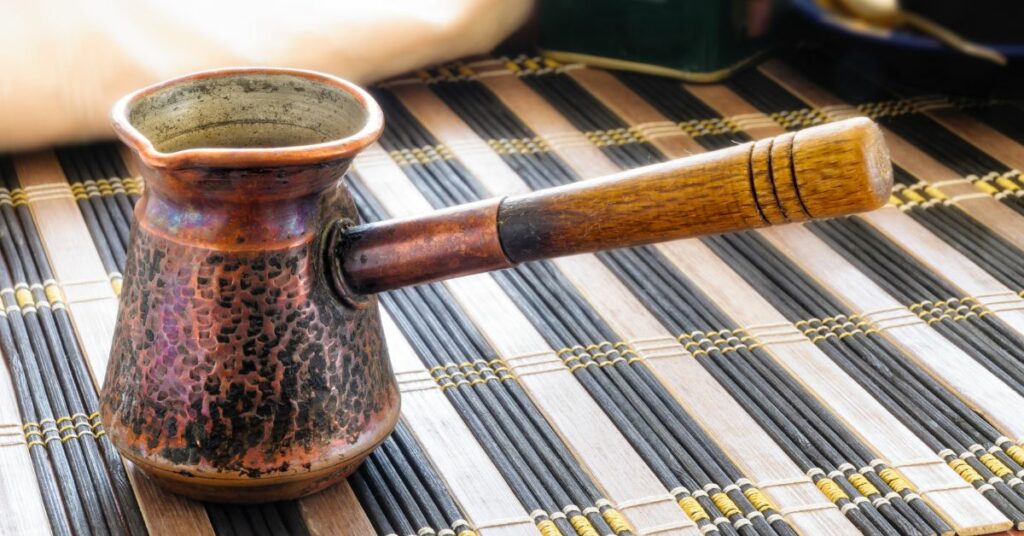As a coffee enthusiast, I want to know everything possible about various coffee types. Upon finding out about Turkish coffee, I knew I had to write about it.
Here’s what you’ll find in this guide:
Dive in to learn more.
Key Takeaways
- Turkish coffee is unfiltered, made with finely ground coffee beans, & typically served strong & thick.
- Often served alongside a glass of water & Turkish delight.
- Variations include Dibek, Menengiç, & Mirra coffee.
- Use extra-fine coffee grounds & a Turkish coffee maker to brew this drink.
What is Turkish Coffee?

| Taste | Bold |
| Aroma | Burnt, nutty, & spicy |
| Mouth feel | Velvety & thick |
| Caffeine | 50–80 mg |
| Calories | 36 |
| Color | Deep, molasses-like brown |
| Other Names | Bosnian coffee (Bosnia) |
Turkish coffee is a drink prepared in a cezve using finely ground coffee beans without filtering. The grounds remain in the coffee and sink to the bottom of the cup when served. Making the drink strong and thick.
A cezve (or ibrik) is a small pot with a long handle and a pouring lip.
You’ll usually see Turkish coffee served with a sweet treat, such as Turkish delight, alongside water. I’ll explain why later.
To make Turkish sand coffee traditionally, you’d fill a pan with sand, then place the cezve on the sand and wait until it froths. From there, you wait until it foams, then remove it from the heat source.
Nowadays, most folks will heat the cezve on a stovetop or similar heating source.
Turkish coffee is famous in the Middle East, North Africa, and the Balkans. It’s also gaining popularity in other parts of the world, as people come to appreciate its unique flavor and aroma.
Here are the different types of Turkish coffee you’ll find.
Types of Turkish Coffee
The following sections will go over variations of Turkish coffee, how they’re made, and what makes them different from Turkish coffee.
1. Dibek Coffee
Dibek coffee differs from Turkish coffee regarding the grinding method. Instead of a coffee grinder, you’d ground coffee beans in a stone mortar and pestle. The term “dibek” means mortar in Turkish.
It’s also brewed in a cezve, but instead of having only coffee like what Turkish coffee has, it could include ingredients like:
- Mastic gum
- Cardamom
- Salep
- Chocolate
- Hazelnut
This coffee drink will have a lighter taste due to the grinding method used and the combination of ingredients.
Here’s another drink.
2. Menengiç Coffee
Menengiç coffee is a caffeine-free drink made from the roasted and ground fruits of the terebinth tree (Pistacia terebinthus). They’re a fruit that’s like pistachios. It’s a traditional beverage in Kurdish and Turkish cuisine, particularly popular in the southeastern Anatolia region of Turkey.
Menengiç coffee has a woody, nutty flavor with a slightly sweet and spicy finish. Many describe it as tasting like a combination of coffee, chocolate, and pistachios.
You’d make this drink by adding 2 cups milk, 2 teaspoons Menengiç coffee, and 1 teaspoon sugar to a saucepan and let it dissolve and boil.
Need caffeine? I got you covered.
3. Mirra Coffee
Mirra coffee (also known as Mırra) is a type of coffee prepared in Turkey’s Hatay, Adana, Urfa, and Mardin provinces. It’s made with twice-roasted finely ground coffee beans to increase the bitter taste.
Mirra coffee is a robust and bitter coffee, and typically enjoyed without sugar or milk. It’s often served as a ceremonial drink at social gatherings, weddings, and religious holidays.
To make Mirra coffee:
- Add 1–2 tsp. of finely ground coffee to a cezve.
- Add a small amount of water & bring to a boil.
- Reduce heat to low & simmer for 5 minutes.
- Strain the coffee into a cup.
Here’s how to make regular Turkish coffee.
How to Make Turkish Coffee
The following sections will cover the best bean type and grind, what you’ll need, and the steps needed to brew Turkish coffee.
Let’s begin with the beans.
1. Best Coffee Bean & Grind for Turkish Coffee
Since you’re not filtering your coffee, grind your beans to extra or extremely fine. Aim for the finest grind possible and make it powder-like.
Any coffee bean type will work. Some will consider arabica as the best bean type to use because they’ll produce a smoother, more flavorful cup of coffee.
Let’s begin with brewing your coffee.
2. Steps to Make Turkish Coffee

Equipment & ingredients:
- ⅓ cup water
- 1 tbsp. coffee grounds
- Cezve/Ibrik
- ⅛ to ¼ tsp. cinnamon (optional)
- ½ to 2 tsp. sugar (optional)
Time to make: 15 mins
Yield: 2 servings
Steps to make:
- Add water & coffee grounds into the cezve.
- Add spices & sugar if desired.
- Stir with a small spoon to mix ingredients.
- Place the cezve on the stovetop & cook at medium-low heat.
- When water starts to boil & coffee foams, remove cezve from heat source.
- Once the foam settles, add the cezve to the stovetop again.
- Repeat steps 3 times; you may need to adjust if coffee tastes too bitter.
- Pour coffee into finjian (cup) & serve.
I’ll talk about what to serve Turkish coffee with in a moment. First, you might wonder how to make this beverage without a cezve/Ibrik.
3. How to Make Turkish Coffee Without an Ibrik
Here’s how to make Turkish coffee without a Turkish coffee maker.
Equipment & ingredients:
- 4 tbsp. ground coffee beans
- Grind it to the finest grind consistency possible.
- 2–3 tbsp. of coffee beans per cup of water.
- 16 fl oz water
- Small pot or saucepan
- Spoon
Steps:
- Add water to your saucepan or pot.
- Add coffee grounds.
- Stir & mix coffee/water combination.
- Use medium heat on stovetop & bring coffee close to a boil.
- As coffee starts to foam, remove the saucepan/pot from the heat source.
- Once the foam settles, repeat steps 4 & 5 once more.
- If you’re worried about bitter-tasting coffee, don’t repeat.
- Serve your drink.
I recommend opting for 2 tablespoons of coffee grounds at first. Because 3 tablespoons per cup will result in a much stronger-tasting drink.
Congratulations. You made Turkish coffee. Now learn how to serve it.
How to Serve Turkish Coffee
First, serve Turkish coffee to any elders in the room. It’s a sign of respect [1].
You’d want to serve Turkish coffee with a glass of water on the side to cleanse your palate while waiting for your drink to cool. You’ll also want to serve it with Turkish delight—a jellied confection—to add a layer of sweetness with your drink.
And you’ll want to stick to a single cup of Turkish coffee. It’s not customary to drink more than a cup, since it’s denser than filtered coffee.
You may have seen the name “Armenian Coffee” floating around. Is it different from Turkish coffee?
Armenian Coffee vs. Turkish Coffee
These drinks only differ because of the addition of cardamom, a spice with a spicy-sweet and minty flavor. The addition of this spice to the cezve when brewing gives Armenian coffee a bit more of a complex taste.
However:
You’d serve both coffees alongside a sugary treat and water. Also, both drinks are brewed in cezves. And they’re served in small cups (fincans).
Both drinks have the same level of robustness due to having identical grind consistencies and brewing methods.
Now that’s out of the way, where did Turkish coffee come from?
History of Turkish Coffee
The history of Turkish coffee begins in 1555, when it was introduced to Constantinople (modern Istanbul) by Syrian traders [2]. The governor of Yemen, Özdemir Pasha, is credited with bringing the drink to the attention of Sultan Suleiman the Magnificent, who quickly became a fan.
Turkish coffee quickly became popular throughout the Ottoman Empire, and soon became an integral part of Turkish culture.
In the 17th century, Turkish coffee began to spread to France and Britain. In the mid 17th century, an Ottoman Jew opened a coffee house that served this drink.
By the time the 1680s rolled around, the Turkish ambassador to France threw parties for the elite where they served the coffee.
Today, Turkish coffee is enjoyed all over the world.
Part of what makes Turkish coffee popular is its ability to tell people’s fortunes.
Tasseography: Telling Fortunes With Turkish Coffee

Tasseography is a form of fortune telling that involves interpreting patterns in tea leaves, coffee grounds, or wine sediments. It’s a practice used for centuries to gain insights into someone’s past, present, and future.
Tasseography is particularly popular in Turkey. After drinking Turkish coffee, the remaining grounds are left to settle at the bottom of the cup. The reader would then turn the cup upside down and the reader interprets the patterns in the grounds.
Here are some examples of Tasseography symbols [3]:
- Angel: Good news with matters related to love.
- Car: Wealth is coming your way.
- Circles: Incoming presents & money.
- Dragon: Sudden changes in life.
The reader will use their knowledge of symbols to interpret the patterns in the cup and give the client a reading. The reading may focus on the client’s past, present, or future. It may also offer advice or guidance on specific issues.
There’s nothing else I can teach you about Turkish coffee. But I can still answer a few questions.
FAQs for Turkish Coffee
Read on to find commonly asked questions about Turkish coffee.
Is Turkish Coffee Stronger Than Espresso?
Turkish coffee is stronger than espresso. It can have up to 80 mg of caffeine; whereas, a shot of espresso has 63 mg.
Why Is Turkish Coffee Served With Water?
You’d drink water alongside Turkish coffee because it cleanses your palate while you wait for your coffee to cool.
Conclusion
Turkish coffee is made using a finely ground, unfiltered brewing method, resulting in a robust taste. Traditional pots called “cezve” or “ibrik” are used for preparation. And if you add cardamom, Turkish coffee would technically become Armenian coffee.
Want to learn more about different coffee drinks? Check out a guide we made that covers most popular coffee drinks.






